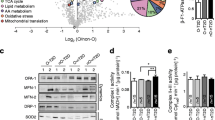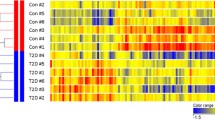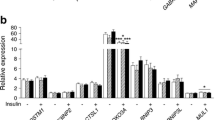Abstract
Aims/hypothesis
Insulin resistance in obesity and type 2 diabetes is related to abnormalities in mitochondrial oxidative phosphorylation (OxPhos) in skeletal muscle. We tested the hypothesis that mitochondrial oxidative metabolism is impaired in muscle of patients with inherited insulin resistance and defective insulin signalling.
Methods
Skeletal muscle biopsies obtained from carriers (n = 6) of a mutation in the tyrosine kinase domain of the insulin receptor gene (INSR) and matched healthy controls (n = 15) were used for discovery-mode microarray-based transcriptional profiling combined with biological pathway analysis. Findings were validated by quantitative real-time PCR, immunoblotting and activity assays.
Results
In INSR mutation carriers, insulin resistance was associated with a coordinated downregulation of OxPhos genes in skeletal muscle. This was related to a 46% decrease in mRNA levels (p = 0.036) of peroxisome proliferator-activated receptor-γ coactivator-1α (PGC-1α), and 25–50% lower protein content of OxPhos subunits encoded by mitochondrial (ND6, p = 0.042) and nuclear DNA (UQCRC1, p = 0.001; SDHA, p = 0.067; COX5A, p = 0.017 and ATP5B, p = 0.005), as well as reduced citrate synthase activity (p = 0.025). Moreover, mutation carriers showed a marked reduction in type 1 muscle fibres (35% vs 62%, p = 0.0005) and increased type 2a fibres (53% vs 32%; p = 0.002) compared with controls. There were no differences in protein content and phosphorylation of 5′ AMP-activated protein kinase, p38 mitogen-activated protein kinase, Erk1 and Erk2.
Conclusions/interpretation
These data indicate that inherited insulin resistance coincides with reduced mitochondrial oxidative capacity in a PGC-1α- and muscle fibre type-related manner. Whether this co-existence is directly or indirectly related to insulin resistance remains to be elucidated.




Similar content being viewed by others
Abbreviations
- ACCβ:
-
Acetyl-CoA carboxylase β
- AMPK:
-
5′ AMP-activated protein kinase
- CS:
-
Citrate synthase
- FDR:
-
False discovery rate
- FWER:
-
Family wise error rate
- GDR:
-
Glucose disposal rate
- GO:
-
Gene ontology
- β-HAD:
-
β-Hydroxy-acyl-CoA dehydrogenase
- IPAQ:
-
International physical activity questionnaire
- MAPK:
-
Mitogen-activated protein kinase
- MHC:
-
Myosin heavy chain
- NOGM:
-
Non-oxidative glucose metabolism
- OxPhos:
-
Oxidative phosphorylation
- PCOS:
-
Polycystic ovary syndrome
- PGC-1α:
-
Peroxisome proliferator-activated receptor-γ coactivator-1α
- PI3K:
-
Phosphatidylinositol 3-kinase
- RER:
-
Respiratory exchange ratio
- REE:
-
Resting energy expenditure
References
Cusi K, Maezono K, Osman A et al (2000) Insulin resistance differentially affects the PI 3-kinase- and MAP kinase-mediated signaling in human muscle. J Clin Invest 105:311–320
Karlsson HK, Zierath JR, Kane S et al (2005) Insulin-stimulated phosphorylation of the Akt substrate AS160 is impaired in skeletal muscle of type 2 diabetic subjects. Diabetes 54:1692–1697
Højlund K, Staehr P, Hansen BF et al (2003) Increased phosphorylation of skeletal muscle glycogen synthase at NH2-terminal sites during physiological hyperinsulinemia in type 2 diabetes. Diabetes 52:1393–1402
Højlund K, Birk JB, Klein DK et al (2009) Dysregulation of glycogen synthase COOH- and NH2-terminal phosphorylation by insulin in obesity and type 2 diabetes mellitus. J Clin Endocrinol Metab 94(11):4547–56. doi:10.1210/jc.2009-0897
Vind BF, Pehmøller C, Treebak JT et al (2011) Impaired insulin-induced site-specific phosphorylation of TBC1 domain family, member 4 (TBC1D4) in skeletal muscle of type 2 diabetes patients is restored by endurance exercise-training. Diabetologia 54:157–167
Adams JM II, Pratipanawatr T, Berria R et al (2004) Ceramide content is increased in skeletal muscle from obese insulin-resistant humans. Diabetes 53:25–31
Lowell BB, Shulman GI (2005) Mitochondrial dysfunction and type 2 diabetes. Science 307:384–387
Szendroedi J, Phielix E, Roden M (2011) The role of mitochondria in insulin resistance and type 2 diabetes mellitus. Nat Rev Endocrinol 8:92–103
Befroy DE, Petersen KF, Dufour S et al (2007) Impaired mitochondrial substrate oxidation in muscle of insulin-resistant offspring of type 2 diabetic patients. Diabetes 56:1376–1381
Kelley DE, He J, Menshikova EV, Ritov VB (2002) Dysfunction of mitochondria in human skeletal muscle in type 2 diabetes. Diabetes 51:2944–2950
Mogensen M, Sahlin K, Fernström M et al (2007) Mitochondrial respiration is decreased in skeletal muscle of patients with type 2 diabetes. Diabetes 56:1592–1599
Phielix E, Schrauwen-Hinderling VB, Mensink M et al (2008) Lower intrinsic ADP-stimulated mitochondrial respiration underlies in vivo mitochondrial dysfunction in muscle of male type 2 diabetic patients. Diabetes 57:2943–2949
Petersen KF, Dufour S, Befroy D, Garcia R, Shulman GI (2004) Impaired mitochondrial activity in the insulin-resistant offspring of patients with type 2 diabetes. N Engl J Med 350:664–671
Ritov VB, Menshikova EV, He J, Ferrell RE, Goodpaster BH, Kelley DE (2005) Deficiency of subsarcolemmal mitochondria in obesity and type 2 diabetes. Diabetes 54:8–14
Szendroedi J, Schmid AI, Chmelik M et al (2007) Muscle mitochondrial ATP synthesis and glucose transport/phosphorylation in type 2 diabetes. PLoS Med 4:e154
Hwang H, Bowen BP, Lefort N et al (2010) Proteomics analysis of human skeletal muscle reveals novel abnormalities in obesity and type 2 diabetes. Diabetes 59:33–42
Giebelstein J, Poschmann G, Højlund K et al (2012) The proteomic signature of insulin-resistant human skeletal muscle reveals increased glycolytic and decreased mitochondrial enzymes. Diabetologia 55:1114–1127
Mootha VK, Lindgren CM, Eriksson KF et al (2003) PGC-1alpha-responsive genes involved in oxidative phosphorylation are coordinately downregulated in human diabetes. Nat Genet 34:267–273
Patti ME, Butte AJ, Crunkhorn S et al (2003) Coordinated reduction of genes of oxidative metabolism in humans with insulin resistance and diabetes: potential role of PGC1 and NRF1. Proc Natl Acad Sci U S A 100:8466–8471
Skov V, Glintborg D, Knudsen S et al (2007) Reduced expression of nuclear-encoded genes involved in mitochondrial oxidative metabolism in skeletal muscle of insulin-resistant women with polycystic ovary syndrome. Diabetes 56:2349–2355
Hock MB, Kralli A (2009) Transcriptional control of mitochondrial biogenesis and function. Annu Rev Physiol 71:177–203
Lira VA, Benton CR, Yan Z, Bonen A (2010) PGC-1alpha regulation by exercise training and its influences on muscle function and insulin sensitivity. Am J Physiol Endocrinol Metab 299:E145–E161
Egan B, Carson BP, Garcia-Roves PM et al (2010) Exercise intensity-dependent regulation of peroxisome proliferator-activated receptor coactivator-1 mRNA abundance is associated with differential activation of upstream signalling kinases in human skeletal muscle. J Physiol 588:1779–1790
Boushel R, Gnaiger E, Schjerling P, Skovbro M, Kraunsøe R, Dela F (2007) Patients with type 2 diabetes have normal mitochondrial function in skeletal muscle. Diabetologia 50:790–796
Højlund K, Hansen T, Lajer M et al (2004) A novel syndrome of autosomal-dominant hyperinsulinemic hypoglycemia linked to a mutation in the human insulin receptor gene. Diabetes 53:1592–1598
Semple RK, Savage DB, Cochran EK, Gorden P, O’Rahilly S (2011) Genetic syndromes of severe insulin resistance. Endocr Rev 32:498–514
Højlund K, Wojtaszewski JF, Birk J, Hansen BF, Vestergaard H, Beck-Nielsen H (2006) Partial rescue of in vivo insulin signalling in skeletal muscle by impaired insulin clearance in heterozygous carriers of a mutation in the insulin receptor gene. Diabetologia 49:1827–1837
Craig CL, Marshall AL, Sjöström M et al (2003) International physical activity questionnaire: 12-country reliability and validity. Med Sci Sports Exerc 35:1381–1395
Ihaka R, Gentleman R (1996) R: a language for data analysis and graphics. J Comput Graph Stat 5:299–314
Huber W, von Heydebreck A, Sültmann H, Poustka A, Vingron M (2002) Variance stabilization applied to microarray data calibration and to the quantification of differential expression. Bioinformatics 18(Suppl 1):S96–S104
Li C, Wong WH (2001) Model-based analysis of oligonucleotide arrays: model validation, design issues and standard error application. Genome Biol 2:1–11
Skov V, Glintborg D, Knudsen S, Tan Q et al (2008) Pioglitazone enhances mitochondrial biogenesis and ribosomal protein biosynthesis in skeletal muscle in polycystic ovary syndrome. PLoS One 3:e2466
Subramanian A, Tamayo P, Mootha VK et al (2006) Gene set enrichment analysis: a knowledge-based approach for interpreting genome-wide expression profiles. Proc Natl Acad Sci U S A 102:15545–15550
Vandesompele J, de Peter K, Pattyn F, Poppe B, van Roy N, de Paepe A, Speleman F (2002) Accurate normalization of real-time quantitative RT-PCR data by geometric averaging of multiple internal control genes. Genome Biol 3, RESEARCH0034
Hellemans J, Mortier G, de Paepe A, Speleman F, Vandesompele J (2007) qBase relative quantification framework and software for management and automated analysis of real-time quantitative PCR data. Genome Biol 8:R19
Jørgensen SB, Treebak JT, Viollet B et al (2007) Role of AMPKalpha2 in basal, training-, and AICAR-induced GLUT4, hexokinase II, and mitochondrial protein expression in mouse muscle. Am J Physiol Endocrinol Metab 292:E331–E339
Ørtenblad N, Nielsen J, Saltin B, Holmberg HC (2011) Role of glycogen availability in sarcoplasmic reticulum Ca2+ kinetics in human skeletal muscle. J Physiol Lond 589:711–725
Sleigh A, Raymond-Barker P, Thackray K et al (2011) Mitochondrial dysfunction in patients with primary congenital insulin resistance. J Clin Invest 121:2457–2461
Semple RK, Soos MA, Luan J et al (2006) Elevated plasma adiponectin in humans with genetically defective insulin receptors. J Clin Endocrinol Metab 91:3219–3223
Iwabu M, Yamauchi T, Okada-Iwabu M et al (2010) Adiponectin and AdipoR1 regulate PGC-1alpha and mitochondria by Ca(2+) and AMPK/SIRT1. Nature 464:1313–1319
Højlund K, Mustard KJ, Staehr P et al (2004) AMPK activity and isoform protein expression are similar in muscle of obese subjects with and without type 2 diabetes. Am J Physiol Endocrinol Metab 286:E239–E244
Højlund K, Glintborg D, Andersen NR et al (2008) Impaired insulin-stimulated phosphorylation of Akt and AS160 in skeletal muscle of women with polycystic ovary syndrome is reversed by pioglitazone treatment. Diabetes 57:357–366
Højlund K, Beck-Nielsen H, Flyvbjerg A, Frystyk J (2012) Characterization of adiponectin multimers and the IGF-axis in humans with a heterozygote mutation in the tyrosine kinase domain of the Insulin Receptor Gene. Eur J Endocrinol 166:511–519
Leick L, Wojtaszewski JF, Johansen ST et al (2008) PGC-1alpha is not mandatory for exercise- and training-induced adaptive gene responses in mouse skeletal muscle. Am J Physiol Endocrinol Metab 294:E463–E474
Andersen JL, Aagaard P (2010) Effects of strength training on muscle fiber types and size; consequences for athletes training for high-intensity sport. Scand J Med Sci Sports 20(Suppl 2):32–38
Stump CS, Short KR, Bigelow ML, Schimke JM, Nair KS (2003) Effect of insulin on human skeletal muscle mitochondrial ATP production, protein synthesis, and mRNA transcripts. Proc Natl Acad Sci U S A 100:7996–8001
Cheng Z, Tseng Y, White MF (2010) Insulin signaling meets mitochondria in metabolism. Trends Endocrinol Metab 21:589–598
Laustsen PG, Russell SJ, Cui L et al (2007) Essential role of insulin and insulin-like growth factor 1 receptor signaling in cardiac development and function. Mol Cell Biol 27:1649–1664
Franko A, von Kleist-Retzow JC, Böse M et al (2012) Complete failure of insulin-transmitted signaling, but not obesity-induced insulin resistance, impairs respiratory chain function in muscle. J Mol Med Berl 90:1145–1160
Snogdal LS, Wod M, Grarup N et al (2012) Common variation in oxidative phosphorylation genes is not a major cause of insulin resistance or type 2 diabetes. Diabetologia 55:340–348
Acknowledgements
We acknowledge L. Hansen, and C. B. Olsen, at the Department of Endocrinology, Odense University Hospital, and B. Bolmgren and C. Christensen at the Department of Nutrition, Exercise and Sports, Copenhagen University for skilled technical assistance.
Funding
The study was supported by grants from the Danish Medical Research Council and the Danish Council for Independent Research (Sapere Aude, DFF Starting Grant), the Excellence Grant 2009 from the Novo Nordisk Foundation and the Lundbeck Foundation. This work is part of the research programme of the UNIK: Food, Fitness and Pharma for Health and Disease (see www.foodfitnesspharma.ku.dk/). The UNIK project is supported by the Danish Ministry of Science, Technology and Innovation.
Duality of interest
The authors declare that there is no duality of interest associated with this manuscript.
Contribution statement
KH is responsible for the integrity of the work as a whole. JMK, VS, HB-N, JFPW and KH were responsible for the conception and design of the study. JMK, VS, SJP, NØ, JFPW and KH contributed to acquisition of data, and performed the analysis and interpretation of data. JMK, JFWP and KH drafted the manuscript, and JMK, VS, SJP, NØ, HB-N, JFWP and KH revised the manuscript critically and approved the final version.
Author information
Authors and Affiliations
Corresponding author
Electronic supplementary material
Below is the link to the electronic supplementary material.
ESM Methods
(PDF 93 kb)
ESM Table 1
(PDF 70 kb)
ESM Table 2
(PDF 26 kb)
ESM Table 3
(PDF 77 kb)
ESM Table 4
(PDF 87 kb)
ESM Table 5
(PDF 29 kb)
ESM Fig. 1
(PDF 279 kb)
Rights and permissions
About this article
Cite this article
Kristensen, J.M., Skov, V., Petersson, S.J. et al. A PGC-1α- and muscle fibre type-related decrease in markers of mitochondrial oxidative metabolism in skeletal muscle of humans with inherited insulin resistance. Diabetologia 57, 1006–1015 (2014). https://doi.org/10.1007/s00125-014-3187-y
Received:
Accepted:
Published:
Issue Date:
DOI: https://doi.org/10.1007/s00125-014-3187-y




